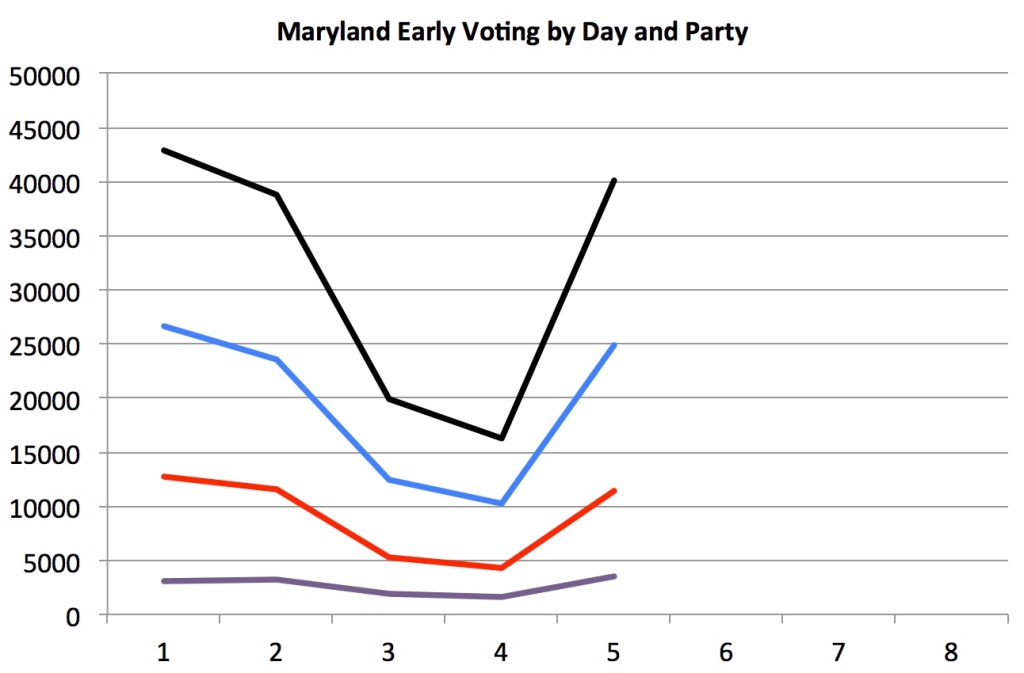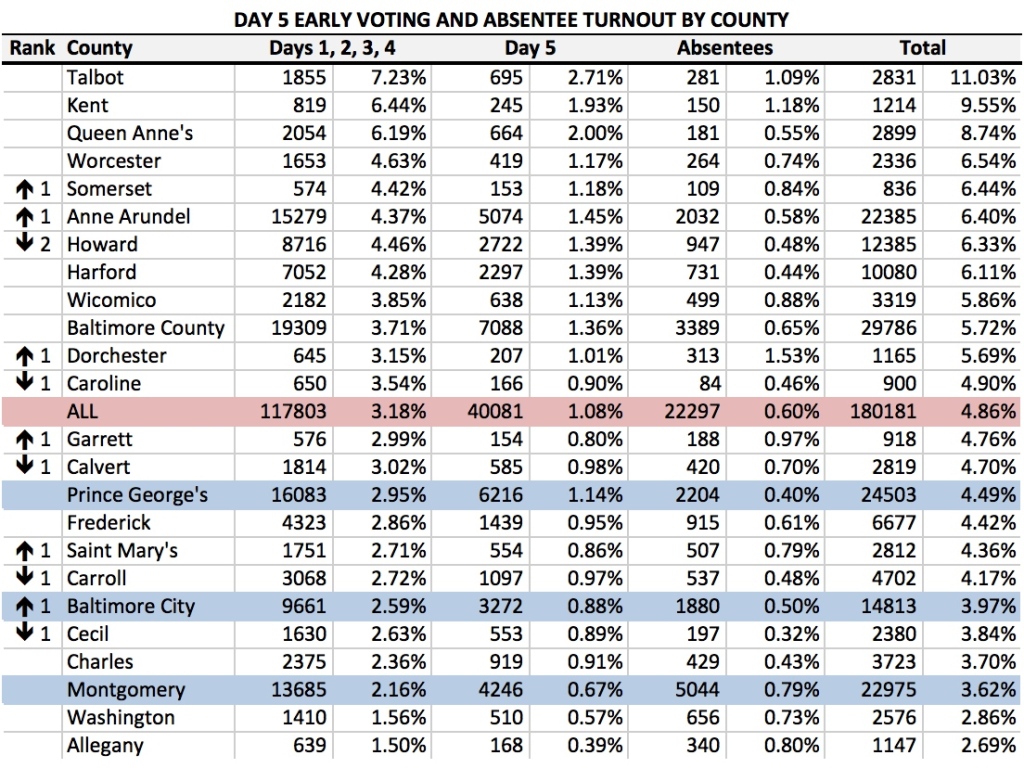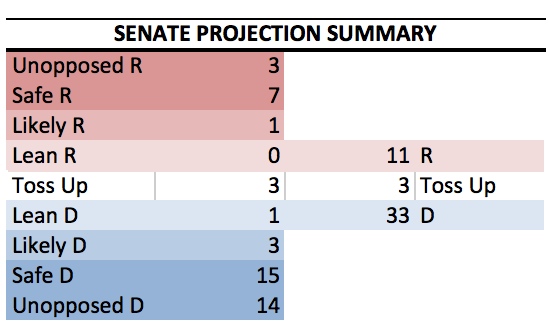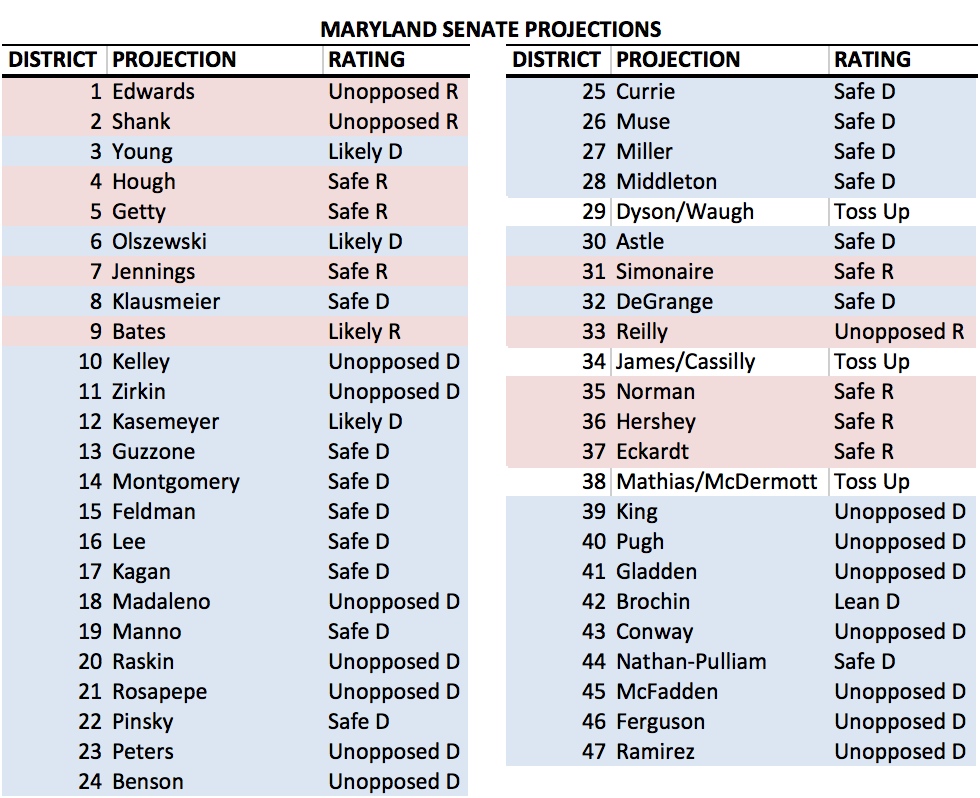Part I looked at the relationship between Trump’s share of the vote and Democratic success in Virginia’s state house elections. Today, I look and see what the Virginia results indicate for Maryland Senate races.
Using a statistical technique called logit, I estimated the probability of Democratic victories in all 47 districts based on the relationship between the share of the vote won by Trump and election outcomes in Virginia.
I also controlled for the presence of Republican incumbents. The statistical model indicated that the relationship is not statistically significant, but the inclusion of this factor results in slightly lower probabilities of success in districts with GOP incumbents. (All Democratic incumbents won and represented seats Clinton won by 15 points, so I cannot similarly control for any advantage held by Democratic incumbents.)
The statistical model suggests that Democrats are most likely to lose 1 or 2 seats in the Senate. A more conservative estimate would be that the Democrats lose 0 to 3 seats. Even a loss of 3 seats would leave Democrats with more than enough to override a Hogan veto should he overcome tough political winds and win reelection.
Which seats are most likely to shift?
Most Vulnerable Democratic Seat
Sen. Jim Mathias defies political gravity in holding Eastern Shore District 38, which gave Trump 61% of the vote – a full 28 points higher than the share received by Clinton. But this former Ocean City Mayor earns it by out hustling his opponents in every way and is a born politician. He beat a delegate in 2014 and will likely face one-term Del. Mary Beth Carozza this year.
District 38 has three subdistricts so Carozza has represented just one-third of the district, including Mathias’s home in Ocean City. She has $114K in the bank compared to $250K for Mathias. Senate President Miller spent big to aid Mathias in 2014 and is prepared to do it again. Hogan and the Republicans have also promised to invest large sums, but the big question is whether Hogan will decide he needs to money for himself.
Despite in theory being a lock for Republicans, this race is a conundrum. Statistically. Mathias should be a dead duck. But the same was true in 2014. Why should Mathias now lose in 2018, expected to be a good Democratic year? Additionally, my model cannot control for any positive impact of Democratic incumbency. I rate it a toss-up.
Vulnerable Democrats?
Recall from Part I that seats that had the potential to go either way in Virginia fell into the range of giving Trump between 40.5% and 48.0% of the vote. Only five Maryland Senate seats fall into this range, all held by Democrats:
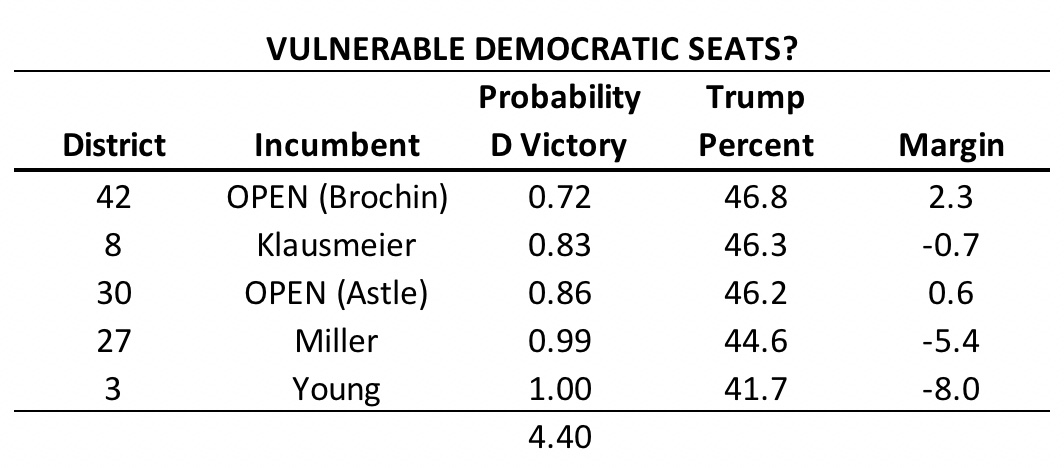
Individually, Democrats are likely to win each of the seats. None are particularly encouraging for Republicans. Collectively, the model indicates a 60% chance of losing one of these seats.
District 3: Frederick
As usual, Republicans plan on going after Sen. Ron Young in Frederick. Good luck with that. The model suggests he is a lock, and this ignores that Frederick has been trending Democratic or that Democrats thumped Republicans in last year’s City of Frederick elections to win control of the mayoralty and city council. Trump lost to Clinton by 8 points in this district. Not going to happen.
District 27: Anne Arundel, Calvert and Prince George’s
Similarly, taking down Senate President Mike Miller would be quite a prize for Republicans. The model gives Republicans a 1 percent shot in this district Trump lost by over 5 points. However, it’s virtually impossible to see how the always well-prepared Miller, the longest serving legislative leader in American history, goes down in territory he has won easily for decades.
District 30: Anne Arundel
The next three seats have Republicans salivating but the model indicates that they are underdogs in each. Sen. John Astle’s retirement from his Annapolis-based district, after losing the primary for city’s mayoralty, leaves a vacancy. Even so, Republicans have only a 14% shot at picking up this district.
Democrats are very pleased with their dynamic and politically experienced candidate, Sarah Elfreth. As in Frederick, Democrats gave Republicans a hiding in the 2017 Annapolis municipal elections. Former Del. Ron George has a clear path to the Republican nomination, as Del. Herb McMillan has given the race a pass. George ran for governor in 2014, losing Anne Arundel to Hogan in the primary by a 2-1 margin. However, George has a bank balance of $169K to $50K for Elfreth.
District 8: Baltimore
Republicans seem to think that they have a shot at taking out Sen. Kathy Klausmeier. The model indicates they have a 1 in 6 chance of victory but that doesn’t take into account any incumbency benefit held by Klausmeier. Their candidate, Del. Christian Miele, doesn’t seem too excited about his prospects, sensing that voter anger with Trump will dominate:
“It definitely gives you some heartburn as a Republican when you see what just happened,” said Republican Delegate Christian J. Miele, of Baltimore County, who is challenging Democratic state Sen. Katherine Klausmeier. “We’re all wondering if 2018 is going to be a continued referendum on the president.”
As Trump’s life goal is to be in the headlines, the answer seems clear. Miele has $87K in the bank compared to $194 for Klausmeier, who is well liked in her district but taking nothing for granted. There are rumors that Miele might just run for reelection for delegate.
District 42: Baltimore
Sen. Jim Brochin is retiring to run for county executive. The most conservative Democrat in the Senate, Brochin had both a tough primary and general last time around. The improved political climate suggests that Democrats have a 72% probability of holding the seat. Del. Chris West (42B) is running for the Republicans. Democrats have two candidates, Robbie Leonard and Gretchen Manavel. Sources tell me Leonard, a former county party chair, has the advantage with local activists but that Manavel has money and the energy – and would be a stronger candidate.
Not Vulnerable
District 32: Anne Arundel
Republicans think they have a good chance of picking up retiring moderate Sen. Ed DeGrange’s seat. Wrong. Clinton carried the district by 12 and it’s not going to happen barring a massive sea change in the political environment. Del. Pam Beidle is a very strong candidate and will win. Republicans are spinning their wheels here.
Vulnerable Republicans?
There are four seats where Democrats hope to play but will likely fall short.
District 9: Howard
Sen. Gail Bates is the most vulnerable Republican but still holds a seat Trump won by nearly 8. The Carroll County portion of her district will likely save her from going down to defeat, as Howard includes less favorable territory even if it is by far the more Republican portion of the county. Democrats have nevertheless recruited a strong candidate in Katie Hester ready to take advantage of any wave.
District 6: Baltimore
For Democrats, this was a real heartbreaker race in 2014 as Del. John Olszewski, Jr., known to one and all as Johnny O, lost by less than 3% to now Sen. Johnny Ray Salling. Democrats think that Salling didn’t so much win as became the accidental senator due to the hellacious political climate. Though Salling is seen as a lightweight who doesn’t work hard in office or at fundraising – he has just $30K in his campaign account – this was territory Trump carried by 15 points that shifted GOP across the board in 2014 and 2016.
Democrats have recruited a local activist and electrician, Bud Staigerwald, who fits the district well and is strongly backed by Comptroller Peter Franchot. Staigerwald lost a primary for Council District 7 in 2014.
District 34: Harford
Sen. Bob Cassilly represents the more Democratic turf in Harford but it’s still Republican and went for Trump by 11 points. Del. Mary-Dulany James, a strong and well-funded candidate, lost by 14.5% to now Sen. Bob Cassilly. Democrats think that they can take Casilly this time around but it will remain tough. Their ability to take advantage of opportunity will improve substantially if the locally deep-rooted James runs again.



